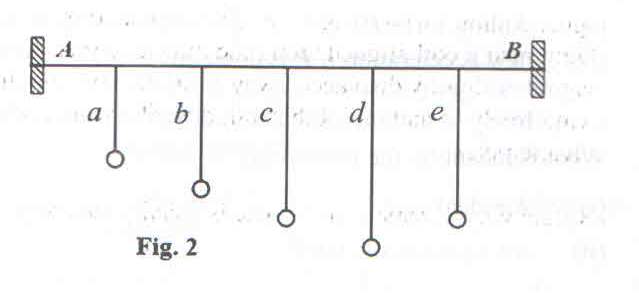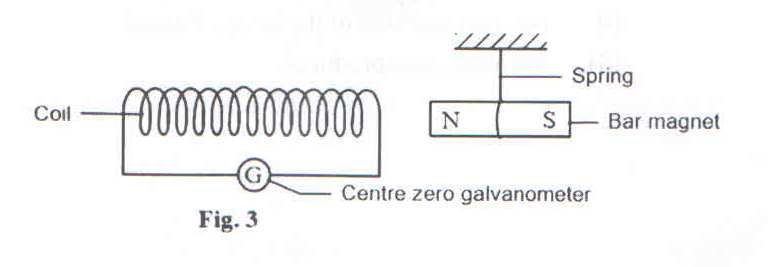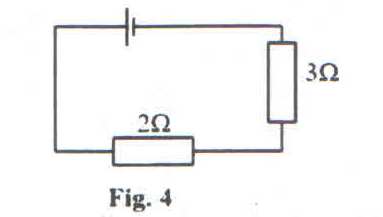1. a) State the law of flotation.
b) The reading on a spring balance when a block of wood is suspended from it is 5 N. When the block is completely submerged in water, the reading of the spring balance is 1 N.
i) State the forces that act on the block when it is completely immersed in water.
ii) Determine the volume of the block.
iii) Explain why the reading of the spring balance will increase when the wooden block is completely submerged in paraffin instead of water.
c) What is meant by terminal velocity?
d) A ball-bearing is released from just below the surface of lubricating oil contained in a tall glass tube.
i) Describe the motion of the ball-bearing from release.
ii) Sketch the velocity-time graph for the motion in (d) (i).
2. a) i) Define linear momentum
ii) State the unit of linear momentum
iii) State the law of conservation of linear momentum
iv) What is the difference between elastic and inelastic collision?
b) i) Explain what happens to a boat at the point when its occupant jumps out of it.
ii) Explain why a person feels heavier than usual at the instant a lift starts accelerating upwards.
c)

A block of mass 10kg, is pulled by a force P on a rough surface as shown in figure 1. If the coefficient of friction between the block and the surface is 0.25 and the acceleration of the block is 3ms-2, find the
i) frictional force F on the block
ii) pulling force P
iii) new acceleration if P is doubled.
3.a) What is meant by the following:
i) An ideal gas,
ii) An equation of state?
b) i) State Charles’ Law.
ii) With the aid of a diagram, describe an experiment to verify Charles’ law.
c) A gas occupies a volume of 12m3 when its pressure is 800 mmHg and its temperature and pressure.
d) Explain in terms of kinetic theory, why the pressure of a gas decreases when its temperature falls at constant volume.
e) Why is it easier to compress a gas than a solid?
4. a) i) Distinguish between primary and secondary colors.
ii) Give two examples of each of the colors in (a) (i)
iii) Explain why an object illuminated by white light may appear colored
b) Given a plane mirror, a converging lens, a screen with a fine gauze wire across a hole at its centre and a torch bulb connected to a dry cell, describe how you would determine the focal length of the lens.
c) An object 10cm high is placed 20cm away from a diverging lens of focal length 15cm.
Determine by scale drawing the,
i) position and size of the image formed
ii) magnification produced.
5. a)

Figure 2 shows a stretched wire AB to which pendulums of lengths a, b, c, d, and e are attached.
i) Which pendulums will have different natural frequencies?
ii) Which pendulums will have the same natural frequencies?
iii) If pendulum e is pulled to one side and released to oscillate freely, explain what happens to both c and e after some time.
b) i) What is meant by a stationary wave?
ii) Describe how a stationary wave corresponding to the first three notes may be produced in a string.
iii) A tuning fork of frequency 515 Hz is held over a resonance tube of length 90cm filled with water. The first and second positions of resonance are obtained when the air column is 18.3cm and 50.5cm respectively above the water surface. Find the speed of sound in air.
6.a) What is a step-down transformer?
b) State three advantages of alternating current (a.c) over direct current (d.c)
c)

Figure 3 shows a bar magnet freely suspended by a string from a clamp near a coil aligned along the magnetic meridian. If the bar magnet is slightly displaced away from the coil and then released to swing freely in and out of the coil, describe what is observed on the galvanometer.
d) Explain why a transformer in use is usually submerged in oil.
c) The number of turns in the primary and secondary coils of a transformer are N and 300 respectively. If the output voltage is 120V when the input is 40 V, find the value of N.
7. a) What is meant by electrostatic induction?
b) Describe how a gold-leaf electroscope can be charged by electrostatic induction.
c) Sketch the electric field pattern outside a positively charged hollow conducting sphere.
d) Explain the dangers of lightning.
e) i) You are provided with an ammeter, a voltmeter, connecting wires and a dry cell in its holder. Draw a circuit diagram you would use to measure the resistance of a resistor R
ii)

A cell of e.m.f E and internal resistance 1.0Ω is connected in series with resistors 2 Ω and 3 Ω as shown in figure 4. If the potential difference across the 3 Ω resistor is 1.5V, calculate the e.m.f of the cell.
8.a) i) What is meant by thermionic emission?
ii) State any four properties of cathode rays.
b) i) Draw a labeled diagram showing the essential parts of an X-ray tube.
ii) Explain how X-rays are produced.
c) i) State any three uses of X-rays.
ii) State two health hazards caused by X-rays
iii) Give two similarities between X-rays and gamma rays.
